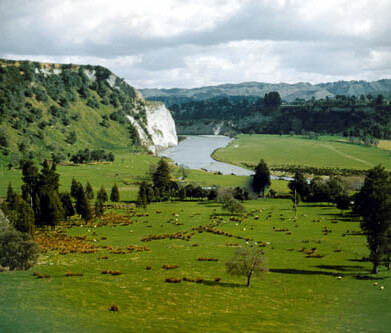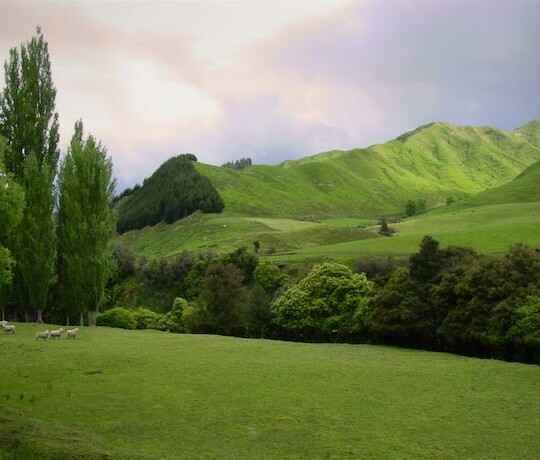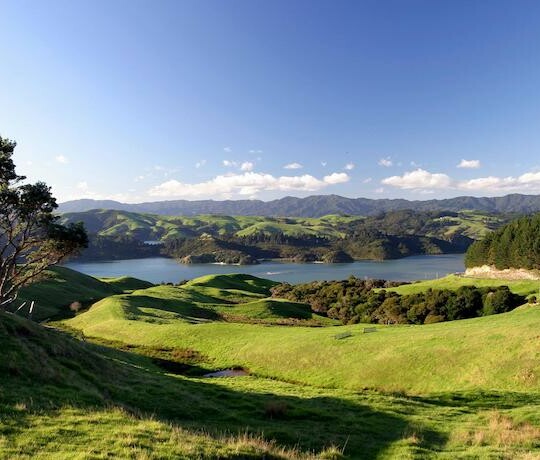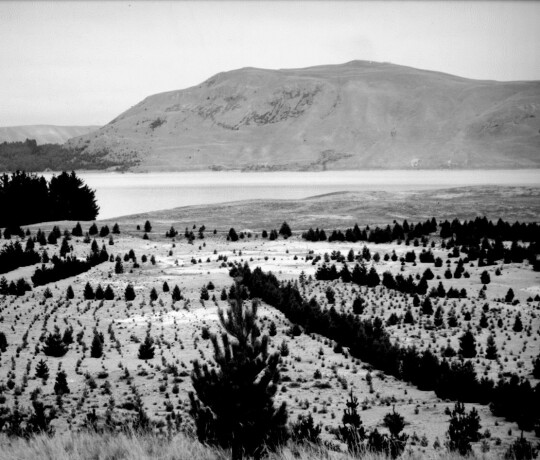Soils
A good soil map is a valuable basis for LUC mapping, especially on flat land and lower slopes where erosion often only plays a minor role.
Soil is an essential part of the physical nature of the landscape and therefore a key inventory factor, and the basis for productive capability of a landscape. It is one of the four limitations within LUC Subclass and it could be limiting sustainable production of the land.
However, the soil factor is one of the more difficult inventory factors to assess and source information. Much of New Zealand’s published soil information is patchy and varies in age, scale and quality.
Detailed surveys are generally restricted to the productive lowlands, while more general soils information is often all that is available for much of the hill and high country. The ability to leverage existing soils information to identify, describe and map soils in the field is an important skill in LRI assessment.
Prior to the late 1990s, most New Zealand soil information is classified in terms of the old NZ Genetic Classification (NZGC) (Taylor & Pohlen 1962, 1968), but subsequently the NZ Soil Classification (NZSC) (Hewitt 1992, 1998, 2010) has been introduced.
These two systems follow different philosophies, and there is no simple 1:1 correlation of NZGC soil groups to NZSC soil orders, or other taxa at lower levels. The table below gives some indication as to how NZSC maps onto NZGC groups.
Table 1: Correlation between the NZ Genetic Classification and the NZ Soils Classification (adapted from Molloy 1998)
| NZ Soil Classification | NZ Genetic Classification | Defining characteristic |
|---|---|---|
| Allophanic Soils | Yellow-brown loams | Dominated by allophane clay |
| Anthropic Soils | Anthropic soils | Man-made soils |
| Brown Soils | Mainly yellow-brown earths (except northern YBEs) and some YB sands, BG, loams and clay | Distinctive brown colourations due to good aeration characteristics |
| Gley Soils | Gley soils or gley recent soils | Water-logged anaerobic soils |
| Granular Soils | Mostly brown-granular (EG) loams and clays | Distinctive granular peds and formed from well-weathered volcanics |
| Melanic Soils | Rendzinas, rendzic intergrades, and some brown-granular loams and clays | Distinctive rich dark topsoils with strong structural developments often associated with limestone |
| Organic Soils | Organic soils | Formed from organic matter (e.g., peat) |
| Oxidic Soils | Strongly weathered red loams, brown loams, some BG loams and clays | Clay soils cominated by oxides (rust) |
| Pallic Soils | Yellow-grey earths | Pale and often dense subsoils |
| Podzol Soils | Podzols | Heavily leached acid soils with a distinctive pale-to-white horizon |
| Pumice Soils | Yellow-brown pumice soils | Dominated by pumice |
| Raw Soils | Some recent soils, and some unclassed soils | Newly formed soils without distinct topsoils |
| Recent Soils | Recent soils | Young soils with distinct topsoils |
| Semi-arid Soils | Brown-grey earths | Formed in a semi-arid climate |
| Ultic Soils | Northern yellow-brown earths, some podzols and some YB sands | Strongly weathered soils with clay-rich subsoils |
It is important to note that all of the original regional LUC legends and units were conceived and defined around the NZ Genetic Classification. And while NZSC attributes have been added to the NZLRI dataset, the relationship between soil sets, series and phases in the NZ Genetic Classification to the NZSC soil classification hierarchy is a many-to-many relationship rather than a simple attribute mapping exercise.
Where the NZ Genetic Classification is used, the 'Series' describes a local soil (e.g., Manawatu soils), the 'Soil Type' differentiates the soil by textural class (e.g. Manawatu fine sandy loam), and the 'Phase' indicates a distinctive characteristic like landscape position, wetness, depth, or stoniness (e.g., Manawatu fine sandy loam, mottled phase).
Series and soil type names tend to find common usage amongst farmers and farm advisors, possibly because they represent local and easy to recognise references. However, the approach is not uniform throughout NZ, and should therefore be used with caution. Officially the ‘regional soil series’ approach is now limited to two components – Series and Phases – whereby the phase includes the textural class.
In the NZSC system, the series / soil types / phases have been replaced by 'families' and 'siblings'. They represent the 4th and 5th level of the NZSC and are defined in Webb & Lilburne (2011).
S-map Online, the digital soil map for Aotearoa New Zealand, provides soils information for approx. 40% of New Zealand soils with more than two thirds (68.5%) of multiple use land (horticulture, cropping and intensive pasture systems) covered at this moment in time.
See section 2.2 of the LUC Handbook for details on soils and LUC.
The digital soil map of New Zealand
S-map Online
The tool also allows you to create custom soil maps and download soil factsheets for specific locations.

S-map Online also provides a Factsheet Browser which allows you to check what former soil series of the the NZ Genetic Classification have become in terms of NZSC families and siblings.
Reference documents for NZ soils
Recommended reading on soil-landscape relationships
NZ Soil Classification (NZSC)
The SoilsPortal provides more detail on the NZ Soil Classification (NZSC), a hierarchical structure with five levels:
- Order: The 15 soil orders are the highest, most generalised level of the classification and provide the national overview of New Zealand soils.
- Groups: The orders are divided into 74 soil groups based on variation in factors such as drainage status, parent material, chemical and physical properties.
- Subgroups: The soil groups are divided into 299 subgroups that provide more detail about the range of soils included in each soil group.
- Family: The soil subgroups are subdivided into family criteria that provide more detail about the soil parent materials, rock class, texture, and permeability.
- Sibling: The soil family are subdivided into sibling criteria that provide more detail about soil depth, stone content, upper and lower textures, and drainage.
Soils develop over time
Most soils – especially those in the South Island – are rather ‘young’ in geological terms and have formed since the end of the last Ice Age, approximately 14,000 years ago. Where soil formation can continue for a longer time (as in in warmer climates on stable land surfaces), deeper and more strongly weathered soil orders will form.
Table 2: This table illustrates an arrangement of NZSC soil orders according to soil age and other soil-forming factors.
| Young soils | Raw Soils | |
| Recent Soils | ||
| Anthropic Soils | ||
| Mature soils Soils that have well developed topsoil and subsoil horizons |
Climate |
Semiarid Soils |
| Pallic Soils | ||
| Brown Soils | ||
| Podzols | ||
|
Wetness |
Gley Soils | |
| Organic Soils | ||
| Rock soil parent materials fromed from rocks that sominate the soil character, e.g. limestone, basalt, pumice and volcanic ash |
Melanic Soils | |
| Pumice Soils | ||
| Allophanic Soils | ||
| Old soils On land surfaces with parent materials that have attributes of advance weathering |
Ultic Soils | |
| Granular Soils | ||
| Oxidic Soils |
Soil orders are divided into Soil Groups based on variation in factors such as drainage status, parent material, chemical and physical properties. For example:
Raw Soils:
- [WG] Gley Raw Soils — periodically wet
- [WH] Hydrothermal Raw Soils — soils naturally warmed by geothermal activity
- [WX] Rocky Raw Soils — rock at shallow depths
- [WS] Sandy Raw Soils — dominated by sand or loamy sand to depth
- [WF] Fluvial Raw Soils — in sediments deposited by flowing water
- [WT] Tephric Raw Soils — in sediments originating as volcanic ejecta
- [WO] Orthic Raw Soils — other Raw Soils
Recent Soils:
- [RH] Hydrothermal Recent Soils — soils naturally warmed by geothermal activity
- [RX] Rocky Recent Soils — rock at shallow depths
- [RS] Sandy Recent Soils — dominated by sand or loamy sand to depth
- [RF] Fluvial Recent Soils — in sediments deposited by flowing water
- [RT] Tephric Recent Soils — in sediments originating as volcanic ejecta
- [RO] Orthic Recent Soils — other Recent Soils, most commonly on slopes

Siblings
Siblings are described by a sequence of up to six functional horizons. Functional horizons are soil horizons (layers of soil material), occurring in soil profiles, characterised by clearly defined soil morphological parameters. They are functional horizons because they are used to predict soil characteristics such as profile available water and hydraulic conductivity.
The comprehensive source of NZ soils information
Soils Portal
It caters for a wide range of users, e.g. land managers, resource managers, teachers and students, in fact, anyone from a soil scientist to a soil ‘beginner’.






